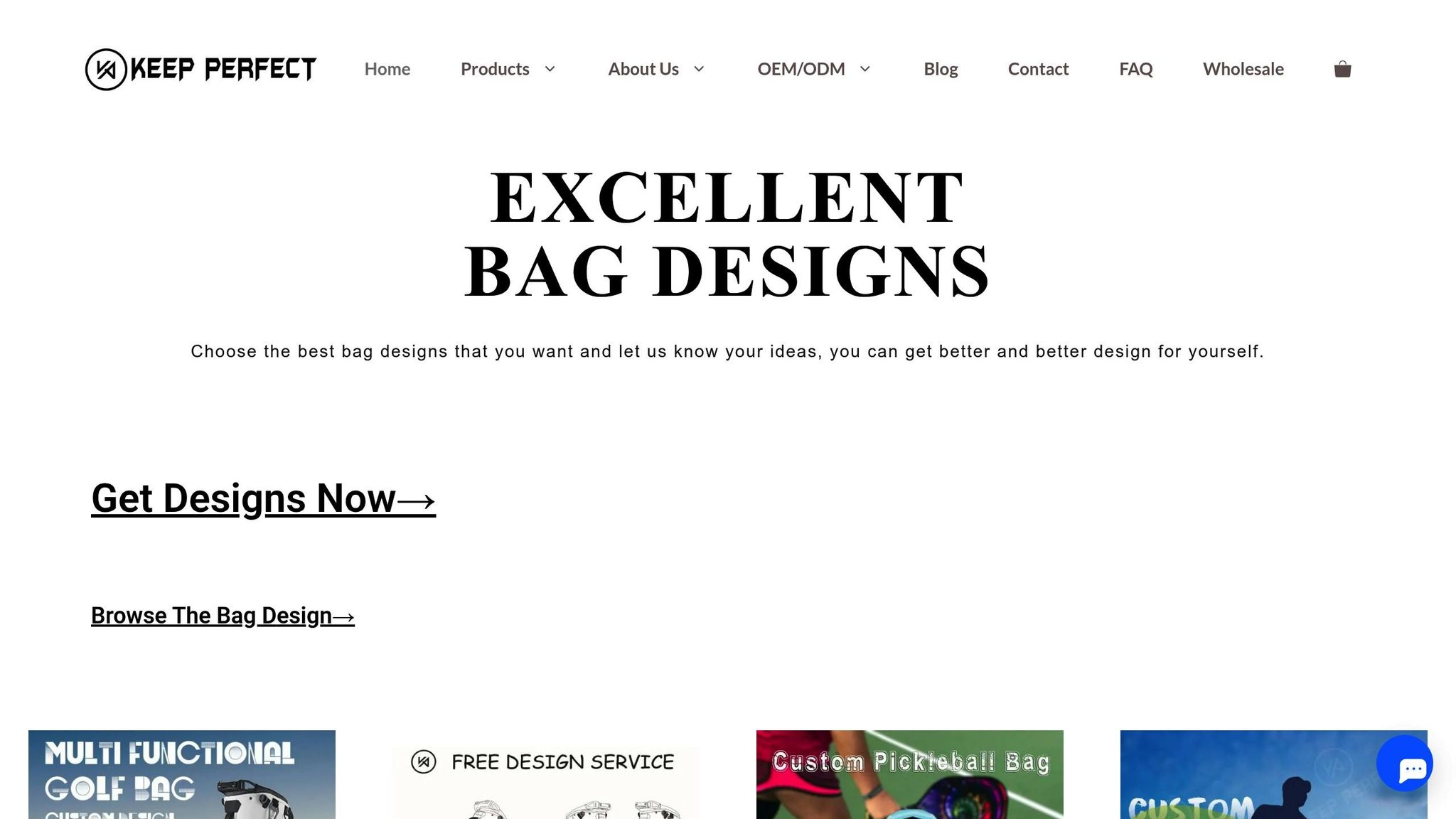Backpacks need to last and keep you organized. This article dives into how top manufacturing practices, premium materials, and smart designs create backpacks that stand the test of time. Here’s a quick breakdown:
- Durable Materials: Ballistic nylon, Cordura, Dyneema, and X-Pac are used for strength and weather resistance. Sustainable options like ECOPAK and hemp are also gaining popularity.
- Precision Manufacturing: Reinforced stitching, heat bonding, and advanced quality control ensure longevity.
- Smart Features: Specialized compartments, USB ports, and anti-theft designs meet modern needs.
- Customization: Companies like JUNYUAN BAGS offer tailored designs, combining quality materials with client-specific features.
The result? Backpacks that blend durability, functionality, and style, lasting up to 8–10 years with proper care.
The PHENOMENAL engineering behind making a backpack
Choosing Materials for Long-Lasting Backpacks
The foundation of a durable, reliable backpack lies in selecting the right materials and putting them through rigorous testing. Factors like durability, weather resistance, and the ability to withstand daily wear all depend heavily on these choices. Let’s take a closer look at the materials that set premium backpacks apart from the rest.
High-End Materials for Premium Backpacks
Top-tier backpacks are built with materials that deliver unmatched strength and performance. One standout is ballistic nylon, originally created for military flak jackets. Known for its exceptional tear resistance, this material’s durability is often measured in denier (D), which indicates its thickness.
Another popular choice is Cordura nylon, developed by DuPont. It strikes an excellent balance between strength and weight, making it a go-to for many high-quality backpacks. A similar option, Kodra, made in Korea, offers comparable abrasion resistance but is often more budget-friendly.
For those prioritizing lightweight strength, Dyneema is a game-changer. This ultra-high-molecular-weight polyethylene boasts a strength-to-weight ratio 15 times higher than steel, making it ideal for applications where every ounce counts.
X-Pac, a composite material made by laminating multiple layers, offers both waterproofing and durability. Its distinctive diamond ripstop pattern prevents small tears from spreading, ensuring long-term reliability.
Sustainability is also becoming a priority in material selection. For instance, ECOPAK fabric incorporates around 20 recycled plastic water bottles per yard, offering an eco-conscious alternative without sacrificing performance. Hemp is another sustainable option, requiring only a third of the water used to grow cotton while providing excellent abrasion resistance and UV protection.
Material coatings further enhance performance. DWR (Durable Water Repellent) treatments help water bead off surfaces, while polyurethane (PU) coatings improve waterproofing. More recently, TPU (thermoplastic polyurethane) has emerged as a durable, flexible, and water-resistant alternative to traditional PVC, aligning with sustainability goals.
Material Testing and Performance Standards
Once the materials are selected, thorough testing ensures they meet performance expectations. Manufacturers simulate years of use through abrasion tests, stress and drop tests, and exposure to extreme temperatures.
Research shows that reinforced seams can increase a backpack’s lifespan by up to 25% compared to standard stitching. This highlights the importance of not just the materials but also how they’re assembled.
Inspections play a critical role in quality control. Hard-shell components are checked for flexibility and resistance to cracking, while soft-shell fabrics undergo tests for tear resistance and weatherproofing. Even smaller elements like buckles and D-rings are tested under load to ensure they won’t fail under pressure.
Industry standards also guide material and product testing. For example, ASTM International provides guidelines like Standard F-2153, which measures backpack capacity. The denier rating system is another useful tool for evaluating fabric durability – higher deniers often mean tougher materials, though lighter options may be preferable for commuter backpacks. More demanding uses, like hiking or travel, benefit from higher-denier fabrics that can withstand heavier wear and tear.
Ultimately, creating a long-lasting backpack requires balancing durability, weight, environmental considerations, and cost. Thoughtful material choices and rigorous testing ensure that the final product meets the diverse needs of its users.
Manufacturing Methods That Extend Backpack Lifespan
Once premium materials are chosen, precise manufacturing processes transform these fabrics into backpacks built to endure years of heavy use.
Strengthened Stitching and Stress Point Reinforcement
Durable stitching at high-stress points is key to extending a backpack’s lifespan. Studies indicate that reinforced seams can increase durability by 25% compared to standard stitching methods.
For example, double-stitching is often applied to critical areas like shoulder straps, zippers, and handle connections to prevent wear and tear. Manufacturers aiming for long-lasting quality often use over 200 stitches per bag, combined with saddle stitching, to ensure the structural strength needed for heavy loads and regular use.
Saddle stitching, a specialized hand-finishing technique, uses two needles and a single thread to create interlocked stitches. This method ensures that even if one stitch fails, the seam remains intact. A blend of machine stitching and hand-finishing reduces production time by 25% while maintaining seam durability.
Heat bonding is another method used in areas where needle holes might compromise waterproofing or fabric integrity. Additionally, molecular bonding – a newer innovation – enhances seam strength by increasing interlayer adhesion, reducing the risk of delamination.
Seam sealing and taping provide extra protection against water penetration and fraying along cut edges. While these techniques may add some weight and bulk to the bag, they significantly improve resistance to environmental wear and extend the product’s overall lifespan.
These advanced stitching and bonding methods lay the groundwork for rigorous quality control, ensuring each backpack meets durability standards.
Quality Control Testing Procedures
To validate the durability of backpacks, manufacturers implement a detailed quality control process that includes four essential checkpoints: incoming quality control (IQC), in-process quality control (IPQC), final quality control (FQC), and outgoing quality control (OQC).
The process begins with material inspection, where fabrics are tested for strength and durability before production starts. Hard-shell components undergo flexibility and crack-resistance tests, while soft-shell fabrics are checked for tear resistance and weatherproofing.
Functional testing evaluates how the finished backpack performs in real-life scenarios, including weight distribution, balance, and maneuverability. These tests can uncover design issues that may not be obvious during visual inspections but could impact usability and longevity.
Stress testing pushes backpacks beyond normal use conditions. For example, handle jerk tests simulate sudden pulling forces, and tumble testing replicates the impacts from travel or daily handling. Additional tests, like those for temperature retention, ensure that extreme environmental conditions won’t degrade the materials or structure.
Defect rates below 3% are a strong indicator of effective quality control measures. Hardware inspections also verify that components like zippers, buckles, and D-rings meet load-bearing requirements.
To further validate quality, many manufacturers rely on third-party testing by internationally recognized organizations. Automated cutting tools enhance precision, improving seam alignment and reducing material waste by 15–20% compared to manual methods.
Ongoing calibration of equipment and regular team training ensure that quality control measures remain effective over time. This attention to detail not only minimizes warranty claims but also strengthens brand reputation and boosts customer satisfaction.
sbb-itb-1e6451b
Smart Organization Features That Improve Backpack Function
Today’s users expect backpacks to do more than just carry their belongings – they need to be thoughtfully designed for work, travel, and even fitness. Smart organization plays a big role in meeting these expectations, working hand-in-hand with durability to ensure every backpack delivers on modern needs.
Effective Compartment Design Methods
The best backpacks go beyond basic storage by offering specialized compartments for shoes, laptops, and accessories. For instance, ventilated shoe compartments help contain odors, keeping them away from clean clothes, while padded laptop sleeves shield expensive devices from scratches and impacts.
Take the Under Armour Adult Hustle 5.0 Backpack as an example. It features a felt-lined laptop sleeve for extra protection and a waterproof front pocket for wet or damp items. Similarly, the Aer Fit Pack 3 steps up hygiene with an antimicrobial-coated shoe compartment, addressing issues that traditional fabric compartments often overlook.
Modular compartments are another game-changer, letting users tweak storage based on their day-to-day needs. The North Face Never Stop Utility Pack comes with a detachable accessory bag that can be repositioned or removed entirely, making it equally useful for light commutes or heavy travel days.
Strategically placed pockets also make a difference. The Aer Fit Pack 3, for instance, includes a felt-lined quick-access pocket for essentials like phones or sunglasses.
Vertical storage solutions are another clever design choice. The Aurorae Yoga Multi-Purpose Yoga Backpack includes a vertical pocket with straps for securing a yoga mat, leaving the main compartment free for other items. This same idea can be applied to keep laptops, tablets, or important documents flat and well-protected.
Modern Features for Today’s Users
Beyond compartments, modern tech and security integrations elevate the overall experience. Built-in USB charging ports are a practical addition, allowing users to charge their devices on the go without needing to fumble for a power bank. Brands like SHRRADOO and MATEIN have incorporated these features into their 2025 models, connecting internal power banks to external USB ports for convenience.
Security is another growing priority. The Pacsafe Venturesafe EXP45 addresses this with reinforced zippers and lockable compartments to protect valuables from unauthorized access.
For those who need flexibility, expandable compartments are a smart solution. The Elite Sports Convertible Bag, for example, includes multiple entry points and a drop-out bottom that increases capacity when needed, making it versatile enough for both daily use and travel.
Insulated compartments add even more utility. While they’re often used to keep drinks cold, they can also protect temperature-sensitive items like medications or electronics from extreme weather. The Elite Sports Convertible Bag takes this concept further with an insulated cooler slot that doubles as a protective space for sensitive gear.
These innovations reflect a trend among manufacturers like JUNYUAN BAGS, who are integrating these features into their designs to create more functional and versatile backpacks.
Organization Feature Comparison Chart
Every organizational feature has its strengths and trade-offs. This table breaks down some of the most popular options, helping users and manufacturers alike understand what works best for different needs.
| Feature Type | Pros | Cons | Best For |
|---|---|---|---|
| Modular Compartments | Customizable layout, adaptable to various uses, replaceable components | Higher cost, risk of losing pieces, more complex assembly | Professionals, travelers with varied needs |
| Fixed Compartments | Cost-effective, simple design, consistent organization | Limited flexibility, harder to clean thoroughly | Students, commuters, budget-conscious users |
| Standard Zippers | Reliable, easy to repair, weather-resistant | Can snag or break, slower access, may freeze in cold weather | Outdoor enthusiasts, heavy-duty users |
| Tech Integration | Convenient charging, modern appeal | Increased complexity, risk of failure, potential for obsolescence | Business travelers, students, tech-savvy users |
| Basic Storage | Lightweight, simple, low-cost | Limited organization, harder to find items | Casual users, minimalist preferences |
Premium backpacks often combine these features to offer the best of both worlds. For example, they might use fixed compartments for core structure while adding modular options for customization, ensuring they cater to a wide range of user needs without sacrificing functionality or efficiency.
Custom Design and OEM Services from JUNYUAN BAGS

Making backpacks that meet top-tier standards for durability and organization isn’t just about using quality materials or advanced manufacturing techniques. It takes a partner who truly understands customization and can deliver on specific needs. JUNYUAN BAGS brings over 15 years of expertise to the table, operating from an 8,000-square-meter facility capable of producing up to 150,000 bags every month. Their focus on customization is woven into every step of the production process.
Tailored Design Options to Meet Your Needs
JUNYUAN BAGS goes beyond simply adding a logo. They offer a wide range of premium materials to suit various styles and functionalities. Whether you’re after the durability of Premium Nylon, the weatherproofing of PVC, the sleek look of PU Leather, the lightweight feel of Oxford Fabric, or the eco-friendly appeal of RPET, they’ve got you covered.
Branding options are just as diverse, including woven labels, silk printing, leather patches, embroidery, and metal emblems. These allow for both understated and bold designs, depending on your brand’s aesthetic. Plus, their customization extends to practical details like compartment sizes, strap lengths, and pocket configurations, ensuring the bag fits your exact needs. For international clients, JUNYUAN BAGS even offers free brand design solutions, turning your ideas into ready-to-manufacture designs.
The OEM Manufacturing Process: Step by Step
JUNYUAN BAGS has a streamlined process that ensures both efficiency and top-notch quality. It starts with a design consultation, where their R&D team collaborates with you to understand your specific requirements and how the bags will be used.
Next comes sample creation. Here, your ideas are brought to life as prototypes that highlight both the design and functionality of the product. Throughout production, quality control is a priority. Materials are tested, seam strength and stitching precision are monitored, and hardware functionality is checked at multiple stages. Before the final shipment, every batch undergoes a detailed inspection to ensure it matches the approved sample.
"Quality is our CULTURE. Service is our Core." – QUANZHOU JUNYUAN COMMERCIAL AND TRADING CO., LTD.
This commitment to quality is backed by certifications such as BSCI audits, FDA, CPC, and RoHS compliance, ensuring their products meet international safety and quality standards. These rigorous processes allow them to deliver solutions tailored to a wide variety of customer needs.
Flexible Solutions for All Types of Customers
JUNYUAN BAGS understands that every customer is different, and their manufacturing approach reflects this flexibility. With minimum order quantities starting at just 100 pieces and a production capacity of 150,000 bags per month, they cater to both small startups and large corporations.
Their customization options are equally versatile. Full customization lets you control every detail of the backpack, from materials and hardware to the interior layout. Design-based customization, on the other hand, focuses on adjusting colors, branding, and specific features while maintaining the bag’s core structure and performance.
Whether you’re an individual, a small business, or a large company, JUNYUAN BAGS offers the same level of design expertise and manufacturing quality. Their approach ensures that every backpack combines durability with thoughtful design, meeting high standards while incorporating advanced organizational features and premium materials.
Conclusion: Creating Backpacks That Meet Top Industry Standards
Making high-quality backpacks involves blending top-tier materials, advanced production methods, and thoughtful design. It starts with durable materials like Cordura, ripstop nylon, and ballistic nylon. Pair these with reinforced seams and double-stitching, and you can extend a backpack’s lifespan by up to 25%.
But materials alone aren’t enough. Precision manufacturing is what transforms them into reliable products. Techniques like automated cutting, industrial sewing, and strict quality control help keep defect rates under 3%. Add ergonomic features such as padded back panels and adjustable straps, and you can reduce user discomfort by as much as 30%.
Practical design is another key factor. Smart compartments, built-in tech features, and intuitive layouts make backpacks not only functional but long-lasting – often up to 8–10 years with proper care. These elements align with the preferences of 85% of users who value durability most when choosing a backpack.
A great example of these principles in action is JUNYUAN BAGS. Their commitment to quality is backed by certifications like BSCI audits and FDA compliance. By combining premium materials, precise craftsmanship, and user-focused design, they’ve created a production system that consistently delivers exceptional products. Their 97.3% positive review rate speaks volumes about their dedication to meeting the high expectations of premium backpack users.
When you bring together durable materials, careful manufacturing, and practical design, the result is a backpack that excels in durability, comfort, and functionality. It’s proof that a well-made backpack can not only meet but exceed user needs, standing strong through years of use.
FAQs
What are the best materials for making durable, weather-resistant backpacks?
When it comes to making backpacks that can handle wear and tear while standing up to the elements, nylon, Cordura, and ballistic nylon are top choices. These materials are tough, long-lasting, and perform well in different weather conditions.
Nylon stands out for being lightweight and water-resistant, making it ideal for daily use. Cordura is a great option if you need extra resistance to abrasions, perfect for outdoor adventures or heavy-duty use. For the ultimate in durability, ballistic nylon – originally developed for military gear – offers excellent protection against rough handling and harsh weather. Choosing any of these materials ensures your backpack will be both durable and functional, without compromising on style.
How do techniques like reinforced stitching and heat bonding make backpacks more durable?
Reinforced stitching fortifies high-stress points, helping to prevent tears and allowing the backpack to carry heavier loads without wearing out quickly. Heat bonding merges multiple material layers, boosting water resistance while keeping the bag sturdy and intact. These methods work hand in hand to make the backpack tougher and last longer.
What features should I look for in a backpack to stay organized and meet modern tech needs?
When picking a backpack, focus on practical organizational features like multiple compartments, padded sleeves for laptops or tablets, and secure elements such as hidden or lockable zippers. For extra functionality, you might want to check out options with built-in USB charging ports, RFID-blocking pockets, or materials designed to resist slashing.
Comfort matters just as much. Look for ergonomic designs with adjustable straps and breathable back panels to make carrying easier. If you’re environmentally conscious, backpacks made from eco-friendly materials can be a great choice, combining durability with a nod to modern values. These details ensure your backpack works well for both convenience and comfort in everyday life.
Related Blog Posts
- From Sketch to Shipment: How OEM Backpacks Are Made (Step-by-Step Video Walkthrough)
- From Concept to Sample: A 15-Day Journey of Custom Backpack Production
- Beyond Tumi: Crafting Custom Luxury Backpacks with Premium Materials & OEM Precision
- Customization is King: Creating Bespoke Backpack Designs Inspired by Tumi’s Aesthetic




 Mobile/What's App/Wechat
Mobile/What's App/Wechat E-Mail
E-Mail ADD
ADD




